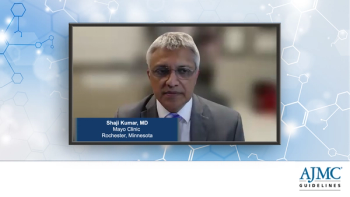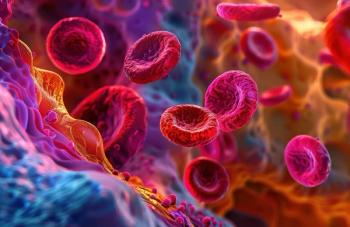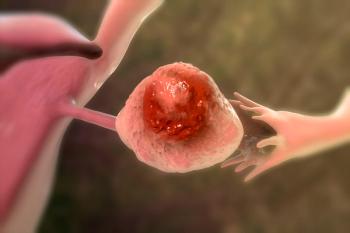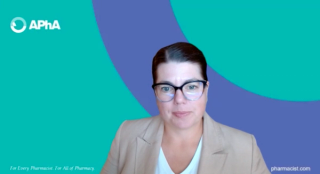
Clinical
Latest News
Latest Videos

CME Content
More News

Shaji Kumar, MD, Mayo Clinic, touches on the complexities of the drug approval process and examines how manufacturing challenges can delay FDA approval. He also returns to the guidelines update and their call to tailor treatment intensity overall and ensure equitable care for Black or African American individuals.

Shaji Kumar, MD, Mayo Clinic, highlights linvoseltamab’s dosing regimen, adverse effect profile, and management strategies. He speaks in particular about cytokine release syndrome, which although common, is typically mild and of short duration, and of proactive prophylaxis to mitigate the risk of severe infection.

Cemiplimab demonstrated a 56% overall survival rate, making it a potential option for physicians to use for treating non–small cell lung cancer (NSCLC).

Refat Rasul Srejon, MPH, recommends employer coverage for substance use care and follow-up, plus research on local treatment and drug trends.

Patients with acute myeloid leukemia (AML) in remission for over 3 years experience survival rates comparable with a matched cohort from the general population.

Female patients with chronic spontaneous urticaria (CSU) face greater disease severity and burdens, particularly in midlife, a study found.

This case highlights the diagnostic complexity and clinical management challenges of dual hematologic malignancies.

Findings from the ROCKET-SHUTTLE trial reveal the benefits of combining the anti-OX40 monoclonal antibody with topical therapies for atopic dermatitis.

Panelists discuss how recent clinical trials like ADmirable and DISCOVER intentionally enrolled patients with skin of color (Fitzpatrick types IV-VI), demonstrating similar efficacy and safety profiles for biologics across diverse racial populations, with more than 70% achieving a 75% or greater improvement in the Eczema Area and Severity Index (EASI-75).

Panelists discuss how historical underrepresentation of patients with darker skin tones in clinical trials has limited understanding of treatment efficacy and safety across diverse populations, hampering real-world clinical decision-making.

Efgartigimod shows promising early response in generalized myasthenia gravis, especially in patients with short disease duration and severe bulbar symptoms.

Although rarely used in psoriatic arthritis (PsA), combination targeted therapy (CTT) appears to have a safety profile comparable to standard therapy.

Ruxolitinib cream 15 mg/g provided rapid, meaningful repigmentation and improved quality of life for adults with nonsegmental vitiligo.

Refat Rasul Srejon, MPH, says reducing opioid-related emergency department (ED) visits among young adults requires strategies like medication-assisted treatment and targeted outreach.

Increased use of neoadjuvant chemotherapy (NACT) with interval debulking surgery has changed surgical practice patterns, improving complete resection rates and reducing postoperative complications.

Shaji Kumar, MD, Mayo Clinic, focuses on the selection, outcomes, and real-world impact of BCMA-targeted bispecific antibodies for multiple myeloma. He emphasizes the factors influencing choice of linvoseltamab, teclistamab, and elranatamab; addresses the impressive results from the LINKER-MM1 trial, which served as the basis for linvoseltamab’s FDA approval; and speaks to linvoseltamab’s new inclusion as a preferred agent in NCCN Guidelines.

Shaji Kumar, MD, Mayo Clinic, discusses the July approval of linvoseltamab, a new bispecific antibody for relapsed myeloma, and how it expands treatment options for patients. He also emphasizes the unique characteristics of linvoseltamab, such as its intravenous administration and flexible dosing schedule.

Although children living with myopia taking atropine did experience an increased incidence of cataracts, glaucoma, or maculopathy, it is unclear if this risk was confounded by myopia severity.

Refat Rasul Srejon, MPH, found that Affordable Care Act (ACA) dependent coverage had mixed effects on young adults’ substance-related emergency department (ED) visits.

The 2024-2025 influenza season saw record-high hospitalization rates, prompting the CDC to emphasize the importance of vaccination and early antiviral treatment.

This study examines the impact of the Affordable Care Act (ACA) on substance-associated emergency department (ED) visits among young adults, revealing reduced alcohol-associated visits but unchanged opioid-associated visits.

Ovarian and uterine cancers linked to high body mass index (BMI) have steadily increased among women of reproductive age, with the greatest burden observed in low- and middle-sociodemographic index regions.

From respiratory conditions to rare diseases and beyond, here are 5 groundbreaking FDA approvals from last month.

Panelists discuss how health care providers need coordinated multidisciplinary care teams, visual resources like databases for eczema in skin of color, peer-to-peer educational sessions, and case-based learning to better recognize and manage atopic dermatitis (AD) across diverse skin tones.

Panelists discuss how treatment access challenges require provider advocacy through peer-to-peer reviews and patient assistance programs, whereas cost-effectiveness evaluation focuses on time to specialist care, therapy duration, and quality-of-life outcomes.


















































